Almost all the kids that grew up in Guildford Junction recall there was something magical about their experience. Whether it’s the memories of their one-room school and teachers, the adventures in their big surrounding playground called the bush, the snakes, the cold and the snow, the isolation, the waratahs in flower or just the scented lupin paddocks dotted around the town. They all have very fond memories. Some have shared those memories on a couple of Facebook pages. In addition, I have shared stories from some who spent part of their youth at Guildford here and here.
This is another story of memories growing up at Guildford by Mott Ryan and Margaret Darby (nee Medhurst). They lived at Guildford in the late 1950s and the early 1960s.
At the end of 1956, the Emu Bay Railway Company (EBR Co.) shifted the gang of fettlers based at Bulgobac to Guildford Junction. They still maintained the same section of railway between Boco siding and the 49-Mile. The No. 6 gang, as they were known, always travelled north into the traffic that came from Burnie. But after the fettler camp burnt down for the second time, it was an excellent opportunity to shift to Guildford and work south away from the railway traffic.
Joe Ryan was part of the No. 6 gang living at Bulgobac with a family of four very young kids (there were eventually to be eight siblings). They moved into the four-bedroom house at the southern end of the Guildford railway platform. It was a large house that used to be the chromite mine manager’s residence from the West Comet chromite mine near Zeehan in the 1920s.
Many fettlers and their families lived at Guildford over the years. The No. 4 gang operated out of Guildford north into the traffic to Highclere until 1962. Then, they shifted to Highclere to work south, away from the traffic on the line. The No. 5 gang maintained the line north from Guildford to the 49-Mile.
The eldest of the Ryan kids was Maurice (“Mott”). Born in 1951, he was already attending the catholic school in Burnie as there was no schooling at Bulgobac. He stayed with his maternal grandparents. When the family moved to Guildford, he went to the Guildford school the following year where Ruby Wilson was the teacher.
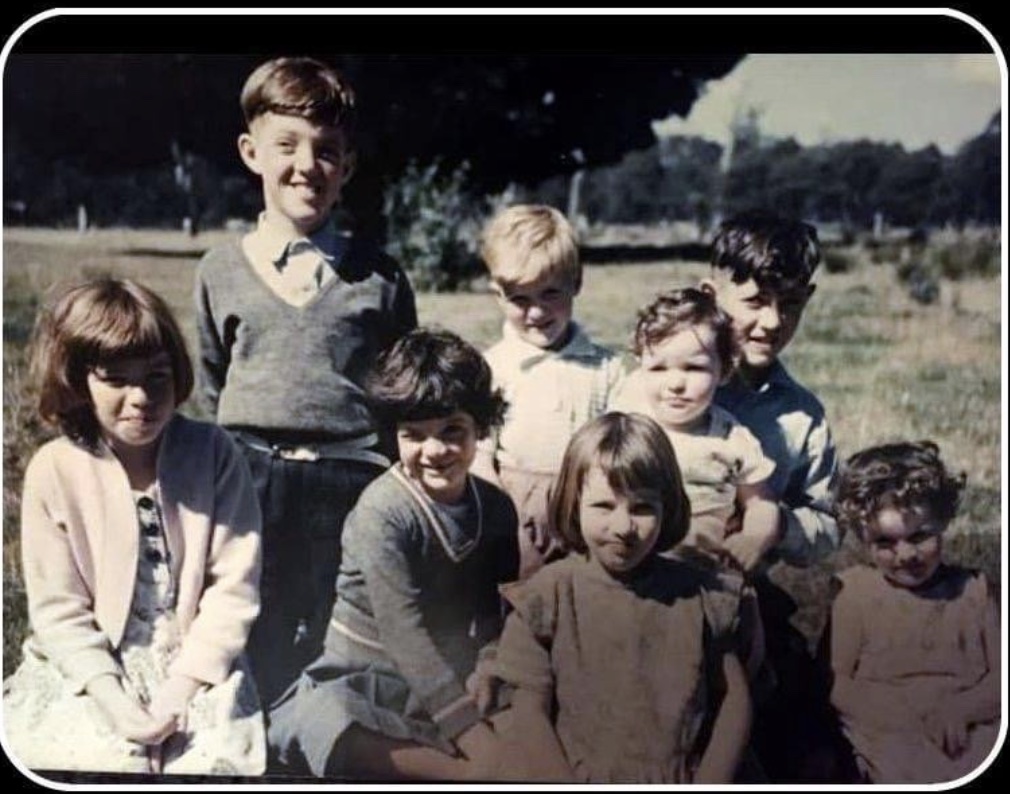
The Ryan kids 1961. L-R Josephine, Mott, Marlene, Leonard, Maria, Paul, Douglas and Eileen. Photo courtesy Mott Ryan.
A little over a year later, William “Jimmy” Medhurst, a carpenter with the EBR Co., was transferred to Guildford, and he arrived with his wife Lila and their six children – Allan, Margaret, Michael, Rodney, Mark, and Peter.
Suddenly half the school was made up of kids from just two families!
The Medhurst’s lived in three houses during their six years stay at Guildford. The first was the bungalow, just outside Guildford on Waratah Road.
School photo 1963. Photo Margaret Darby.
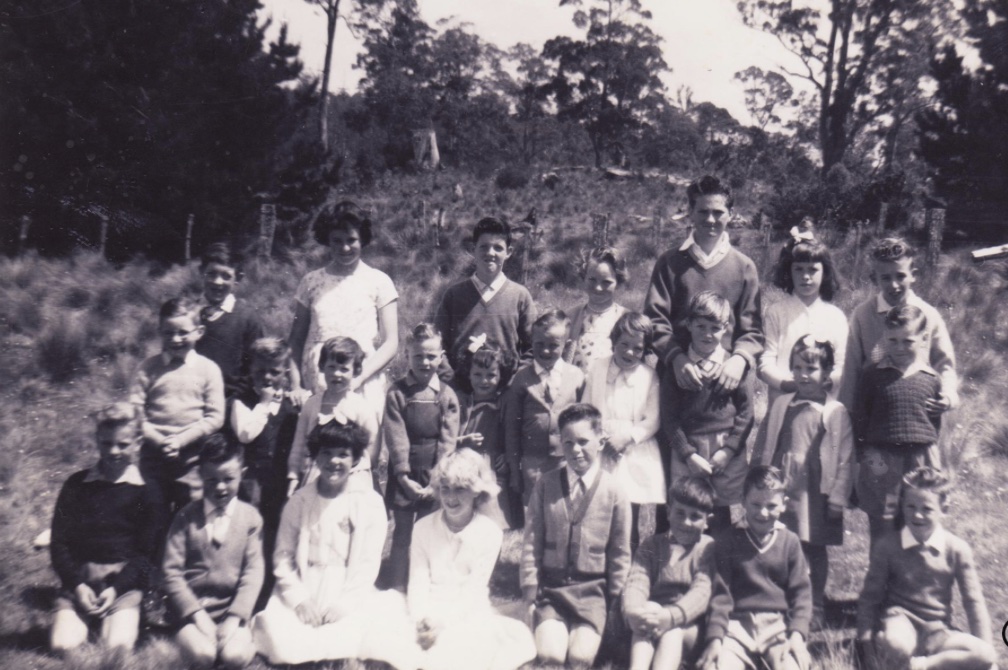
L-R Back: Douglas Ryan, Judith Barber, Mott Ryan, Margaret Medhurst, Allan Medhurst, Josephine Ryan, Peter Whelan. Middle; Dale Crisp, ??, Mark Medhurst, Maria Ryan, Shane Whelan, ??, Leonard Ryan, Eileen Ryan, Rodney Medhurst. Front Micheal Medhurst, Nigel Burridge, Marlene Ryan, Lynette Burgess, Terry Chatwin, Stephen Palmer, Michael Palmer, Chris Burgess.
Can anyone fill in the gaps?
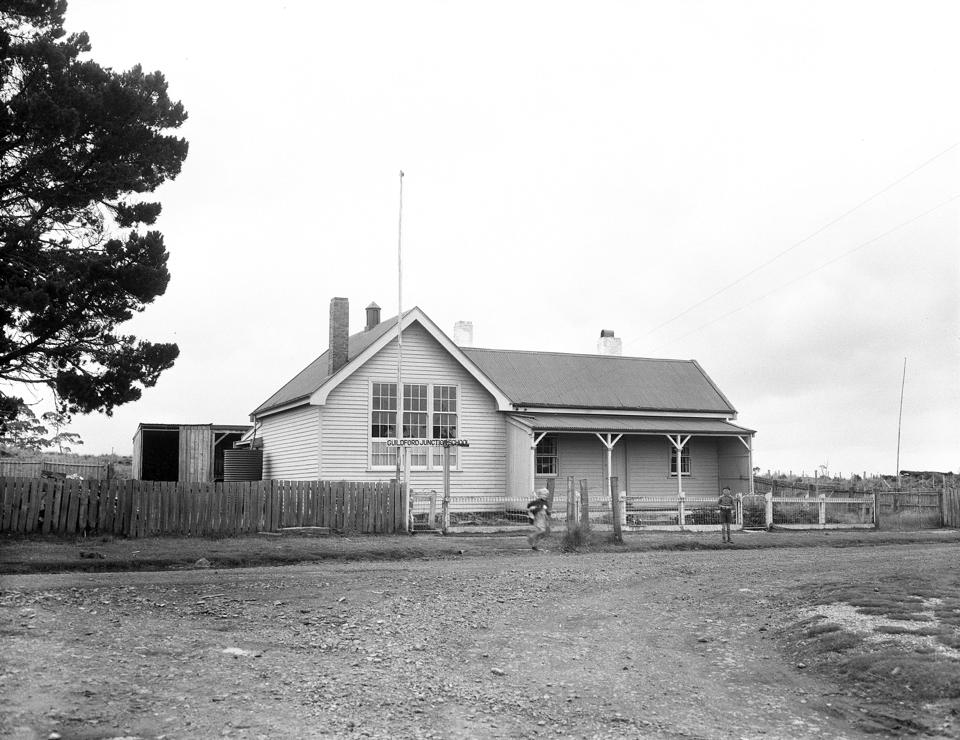
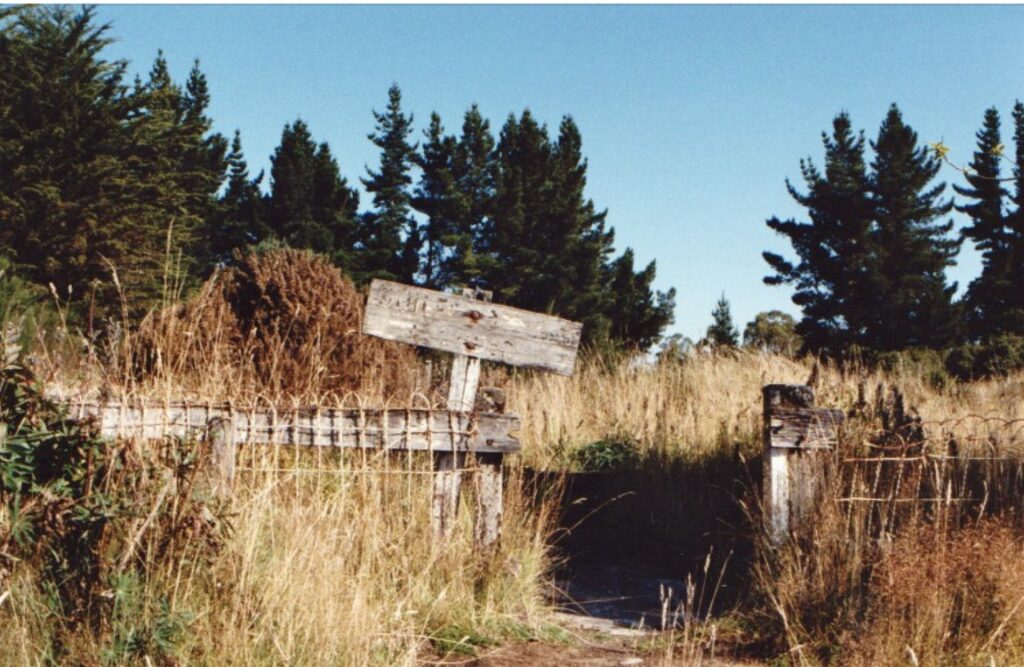
At recess, the school kids got bottled milk which changed to flavoured milk in the early 1960s. The one-room school had an open fireplace to keep the children warm. Margaret remembers sitting so close to the fire for too long that she melted the bottom of her shoes. She had to hide them from her mother as she ensured each kid’s shoes were clean daily. The kids used to walk the short distance home for lunch each day.
Sunday school was held at the school every Sunday. Margaret still has some of the books presented to her for her attendance. One of the other families in town usually donated them.
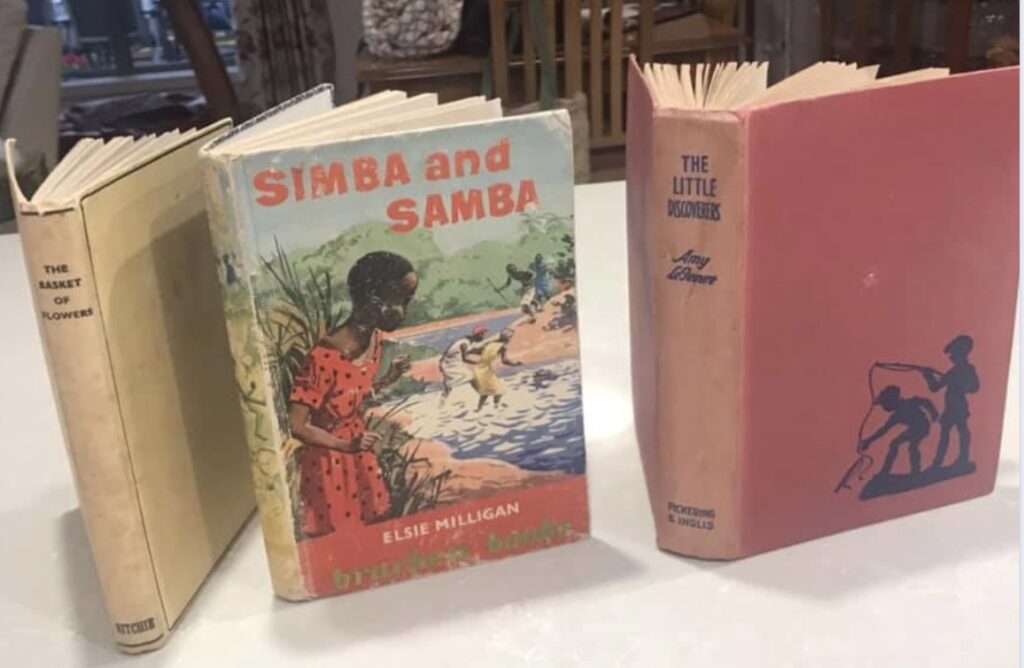
Some of the books awarded to Margaret. Photo Margaret Darby.
Mott remembers spending a lot of time alone after school and on weekends wandering the bush, sometimes as far as five miles away from town. He never got lost. Joe was a good bushman and passed on his skills to young Mott, so much so that Mott was “as wild as a native hen”.
Mott at the old boiler, Cummings sawmill site. Photo Mott Ryan.
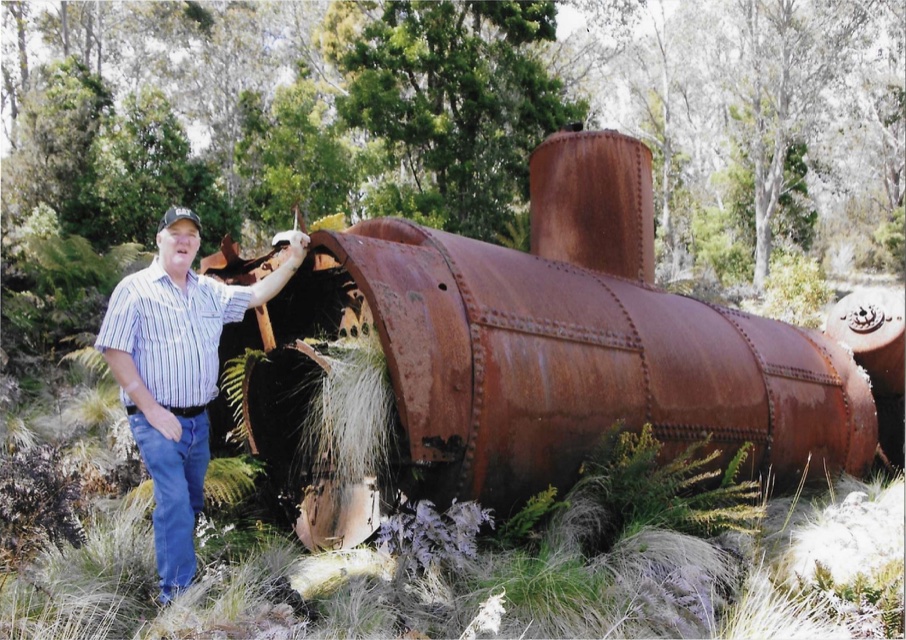
He would go fishing at Muddy Creek, where there were always beautiful trout. Another favourite place was to wander around the nearby Cummings Bros. sawmill site after they had finished for the day. Mott also spent many hours with his father after school. When Joe finished work at 3:30, he often went into the bush to square sleepers for extra money. Mott said he learnt a lot from those experiences.
Many snakes were around, usually found under every bit of tin lying around or under a log. Margaret and one of her brothers decided to hunt some snakes and killed 13 one day. Some were the smaller whip snake, and others were the much-feared tiger snake. One day when Margaret and Lynette Burgess went for a walk to the water wheel, Lynette saw a giant tiger snake which reared dangerously at them. In fear, Margaret, holding a kitten, lost it into the creek and took a while to rescue it.
They eventually hurried back home, and Margaret was so scared she had trouble telling her parents what had happened.
Snow was a common occurrence at any time of the year. Margaret recalls there was so much one day that Joe Fagan’s front-end loader had to make a track leading to the school.
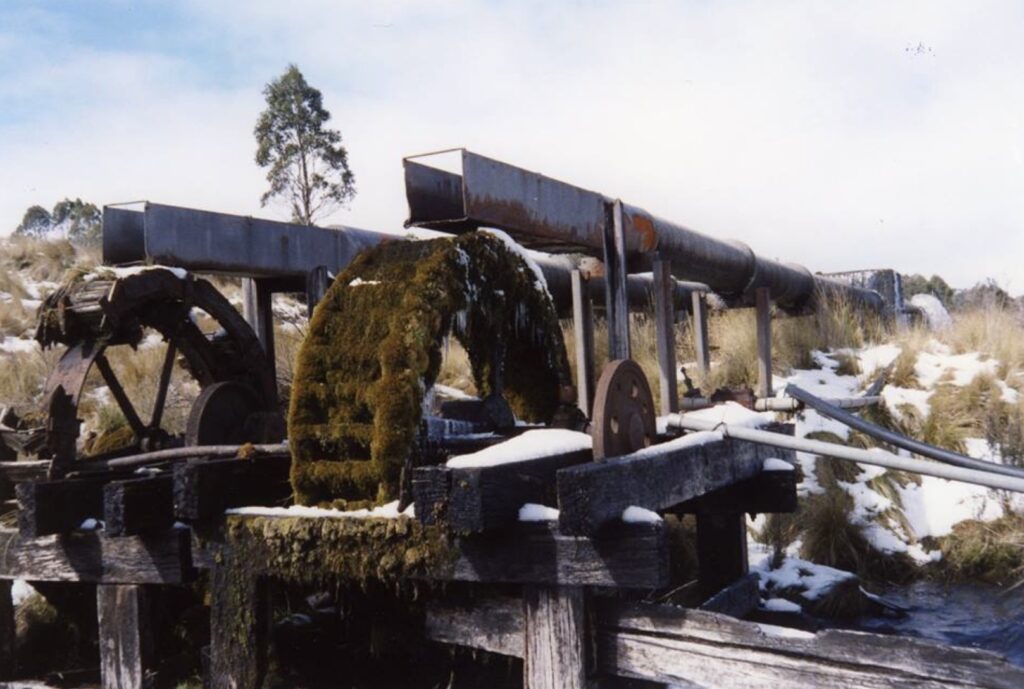
The water wheel. Photo Winston Nickols.
The hall at Guildford was an old railway locomotive shed with two tracks in the centre and was the social hub for the settlement. It hosted annual Christmas celebrations, birthday parties and other social functions. However, it wasn’t quite big enough for the badminton court, where the boundary for one side of the court was on top of the 11/2-inch skirting board, and the ceiling was relatively low as well. It favoured the local players used to the limitations, but visiting players from Waratah didn’t like the more cramped conditions.
One Christmas, the Medhurst kids decided they wanted a real pine tree to decorate with the streamers they made from crepe paper. There was a plantation of pine trees nearby owned by AFH. Margaret led her younger brothers to cut one down with an axe.
They didn’t want anyone to know what they had done. So, once cut, all the children took up stations along the length of the log and quickly hurried home without anyone seeing them. However, their mother was not very pleased and made them return the tree; otherwise, they would go to jail. With their tails between their legs, they took the tree back and hid it in the bush. To further hide any evidence of wrongdoing, Margaret had to cut the stump out of the ground without any help from her brothers.
Noel Barnes as Santa Clause outside the hall, 1961. Photo Margaret Denby.
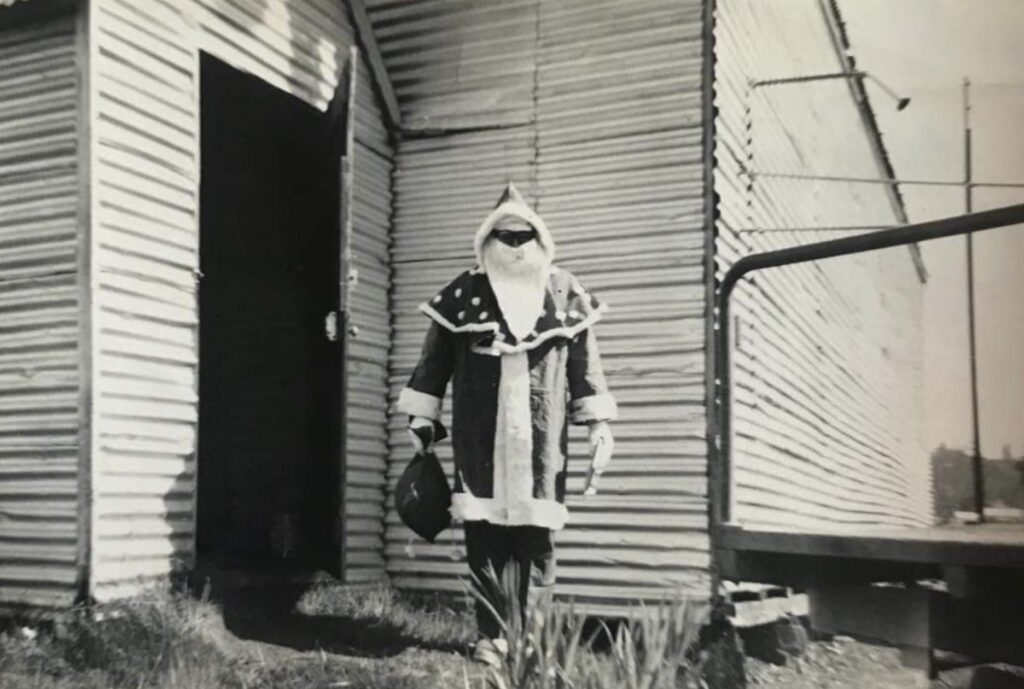
Mott’s father, Joe, usually cut a good size celery top pine in the bush near Que River and sent it to Guildford via the railway as the town’s Christmas tree in the hall.
A popular tradition for the kids of Guildford to earn some pocket money was to pick the wonderful bright red waratah flowers in season from about November, bundle them up with some ferns and sell them to passengers at the railway station for two shillings a bunch.
The tradition started in the 1930s and 40s when the train to Waratah stopped, and passengers alighted for refreshments. In the early 1960s, it was popular again with the West Coaster. Eileen and Maria Ryan always dressed in beautiful Rose dresses and buckle shoes to sell the bunches of Waratah flowers.
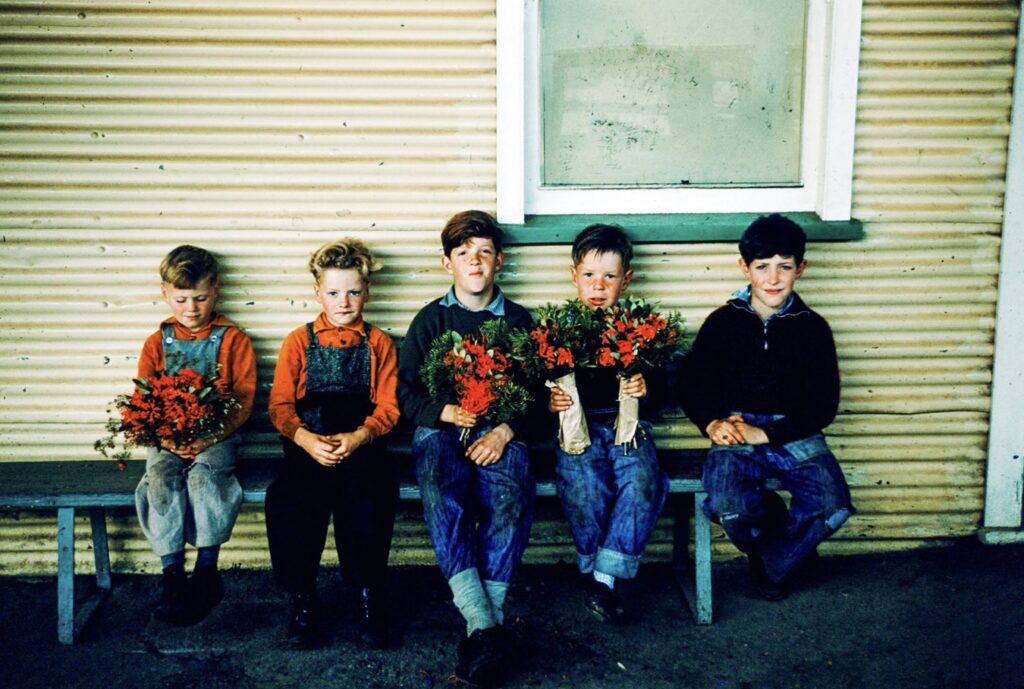
Not just the girls selling a bunch of waratah flowers at the railway. L-R Rodney Medhurst, Michael Medhurst, Mott Ryan, Leonard Ryan, Douglas Ryan. Photos Ted Coote, courtesy Greg Coote.
Several horses grazed in the paddocks at Guildford. Nugget was a draught horse from the Cummings sawmill that operated until the early 1960s, and Spider was the black horse in the paddock next to the school. He was a grumpy horse and mainly didn’t like men. Lorraine Perry (nee Thorp), the station master’s daughter, looked after Spider for many years. Belle was a Bay mare purchased by Charlie Wilson in the early 1950s. She was transferred to Guildford per rail in a wagon. When the family left Guildford, Charlie thought it would be better to leave her there just to roam with the other horses. Unfortunately, Belle was hit by a train late one night and died. Charlie also owned a black pony called Black Bess. Spider died in 1982 and was buried in his yard. Margaret used to enjoy climbing the fence to mount Spider for a ride.
Margaret on Spider, 1961. Photo Margaret Darby.
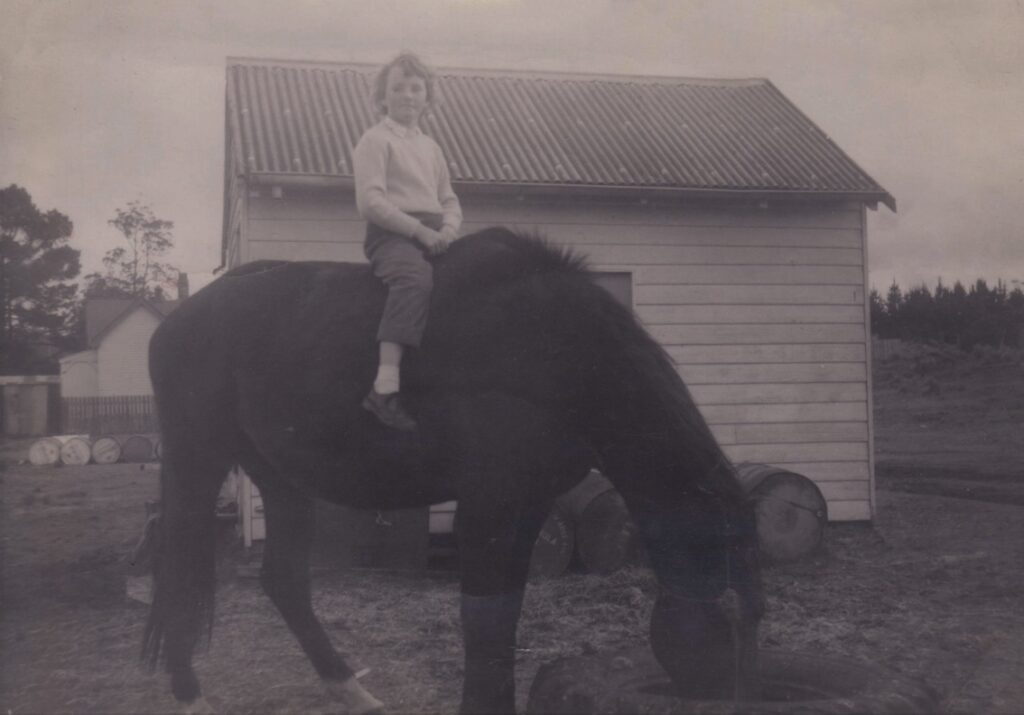
The arrival of the West Coaster in 1960 to transfer cars from the north coast, many of which had travelled across the Bass Strait on the new Princess of Tasmania car and passenger ferry, allowed tourists and locals to visit the West Coast. The train would leave Burnie in the morning, stop at Guildford to load the cars and buses that travelled there by road, and dismount at Rosebery to explore the west coast. To distinguish the west coaster as a separate service, the EBR Co. painted the black dubs blue. When the locomotive pulled into Guildford for the first time, a strong memory of Mott’s was the smell of burning paint that was very noticeable to the residents.
The Medhurst family suddenly left Guildford in 1964 and moved to Port Sorell. The eldest child, Allan, remained as he had already left school and was working for AFH on the repair crew with Peter Edmunds and then with the rock crusher.
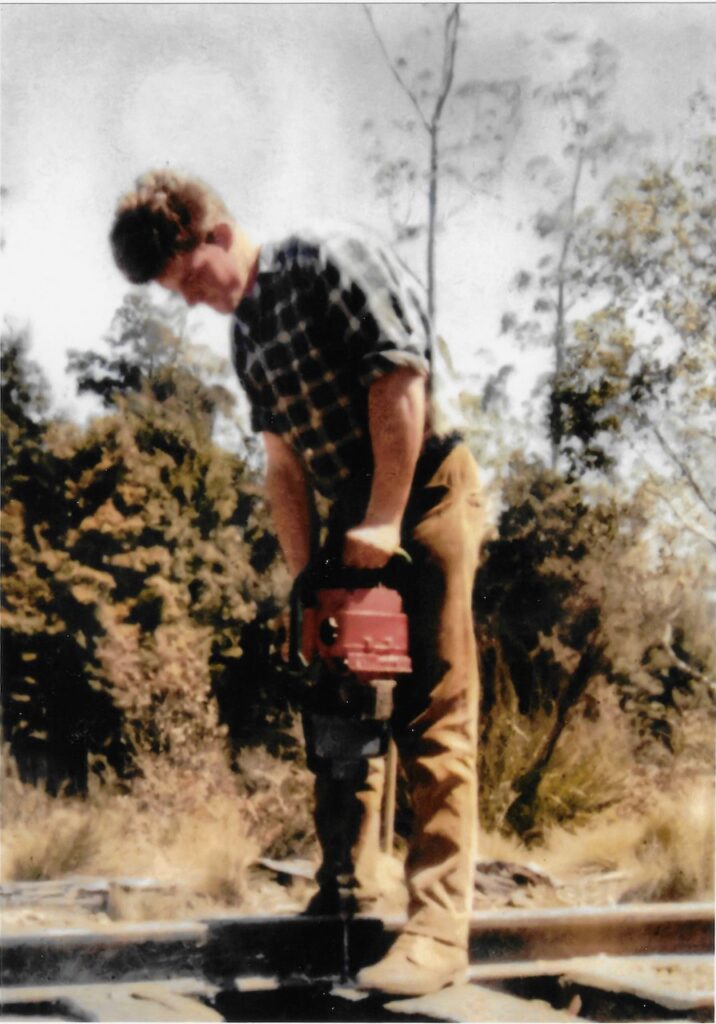
Mott left school in 1965, not even 14 years old and started working with AFH. He initially also worked with Peter Edmunds on the gravel truck and then moved to the smaller Skagit under the guidance of Lloyd Saward. However, after 14 months, he applied for a job as a fettler with the EBR Co. because the pay was better.
Still not yet 15, Mott lied on his application form, claiming to be 18 years old. Nevertheless, he got the job and worked with his father in the No. 6 gang. He later worked in the mining industry and ran the biggest private underground mining contracting business in the Southern Hemisphere, based out of Western Australia.
Both Mott and Margaret have returned to Guildford in recent times. While there isn’t much to see these days, Mott has seen the remnants of the old blocks dug into the ground for a chopping block in the underhand wood chopping event as part of the sports carnival held at Guildford.
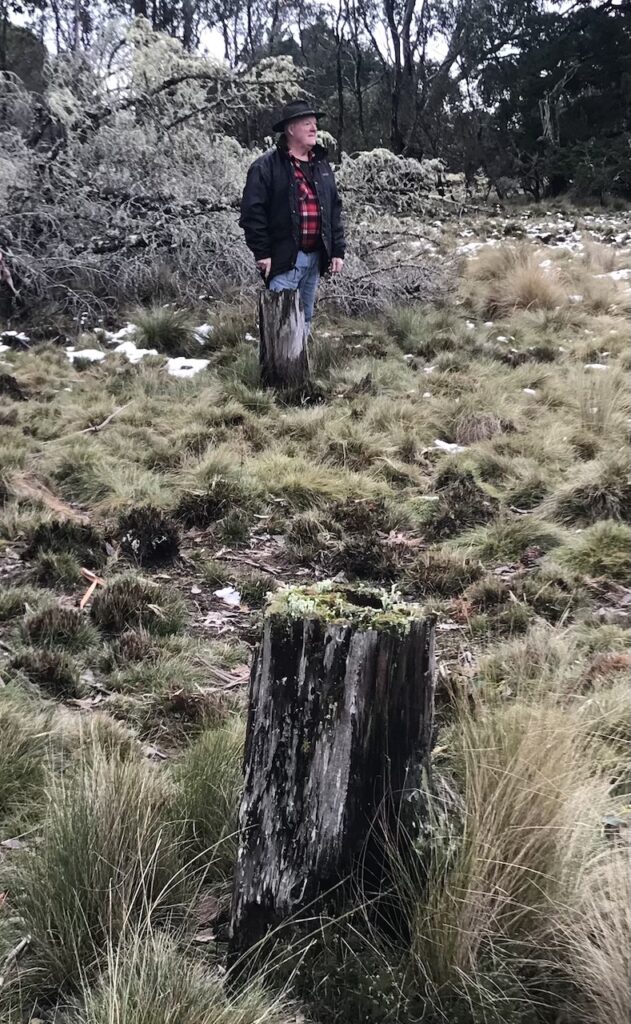
Mott at Guildford recently at the woodchopping arena. Photo Margaret Darby.
There are many fond memories of Guildford from the kids that grew up there. As well as the stories on my website, many other memories and photos have been shared on the Guildford Junction and Waratah Facebook pages. While the town no longer exists, sharing memories helps keep the history of this unique and isolated Tasmanian town alive for years to come.
If you also have memories from living at Guildford Junction, please share them on the comments. If you would to share your memories as a story let me know.
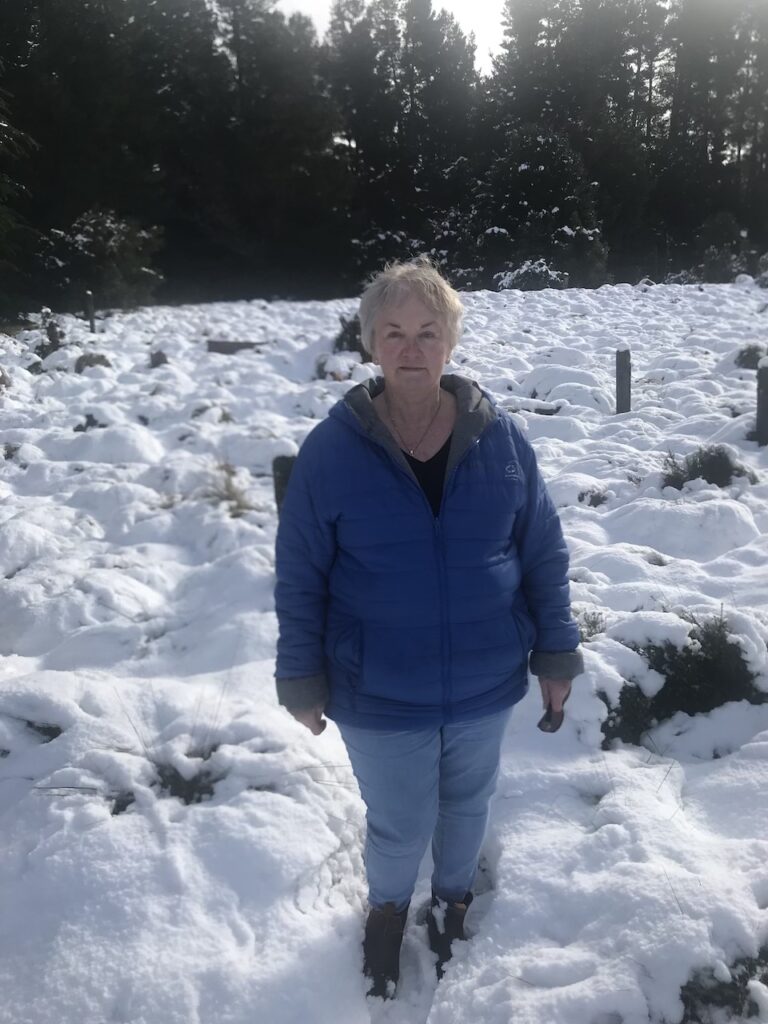
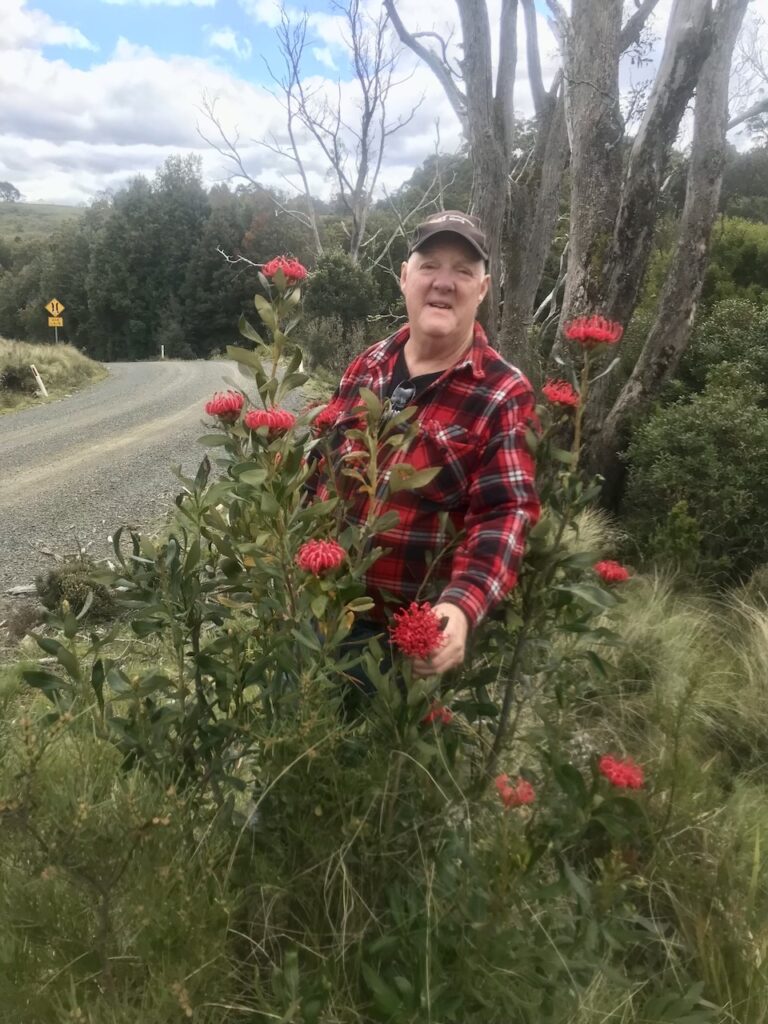
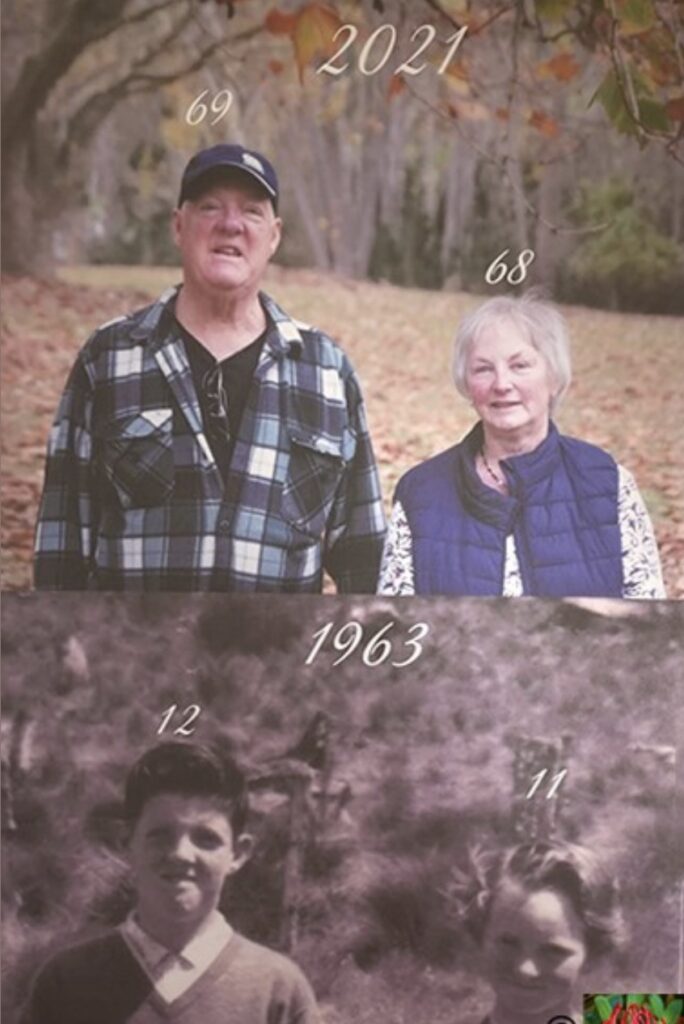
An evocative article.
Being a child myself around the same time as Mott and Margaret [you were a little bit earlier Janet!], it was interesting to read their memories of their growing years in Guildford to comparing my memories of my childhood growing up in the UK. What a difference!
What a great story Robert. There were 8 children in the Ryan family as can be seen in the family photo.
Apologies Mott. I checked that I said eight in the story.
A wonderful read, Robert. Thank you.
Recording these memories and stories certainly capture a moment in time of families and life in a now non-existent town. Special.
Life was certainly different then, and it is wonderful to have been brought up in a similar era, although not at Guildford. They are cherished memories. Weren’t we very lucky.
Great to read the story about life at Guildford. Many of the stories are similar to my father’s, Cyril Hills, who lived there on late 30s and early 40s.
He would have enjoyed reading it and reminiscing about his younger days. Good to keep Guildford memories alive.😀
The best memory of Guildford was the sandwiches made by Mrs. Burridge. Often this was my lunch. When I travelled with the paymaster, sandwiches and some beer was our lunch.
A wonderful story of life as it used to be in the bush. Well written Robert.
I spent a few Wednesday nights at Guildford when falling in the pulp bush, having a few beers with Frank Burridge. Mrs Burridge always made a plate of those famous ham sandwiches.
Those days are gone forever but memories remain.
Ruby Wilson was my aunt and also taught me at Guildford.
My family lived in Guildford from 1950 until 58. I have many of the same memories of the people in the story. The school room, Mrs Wilson, Sunday School, lupins in front of our house, all the kids having bicycles, selling waratah bunches to rail motor travellers, the fettler huts and railway lines and station, the dances in the hall, school breakups at end of the year and Santa coming.
I was not at school when Queen Elizabeth came through Burnie and travelled with Mum and Dad to see the parade in our Pontiac car. I was told that the school children travelled by bus that day.